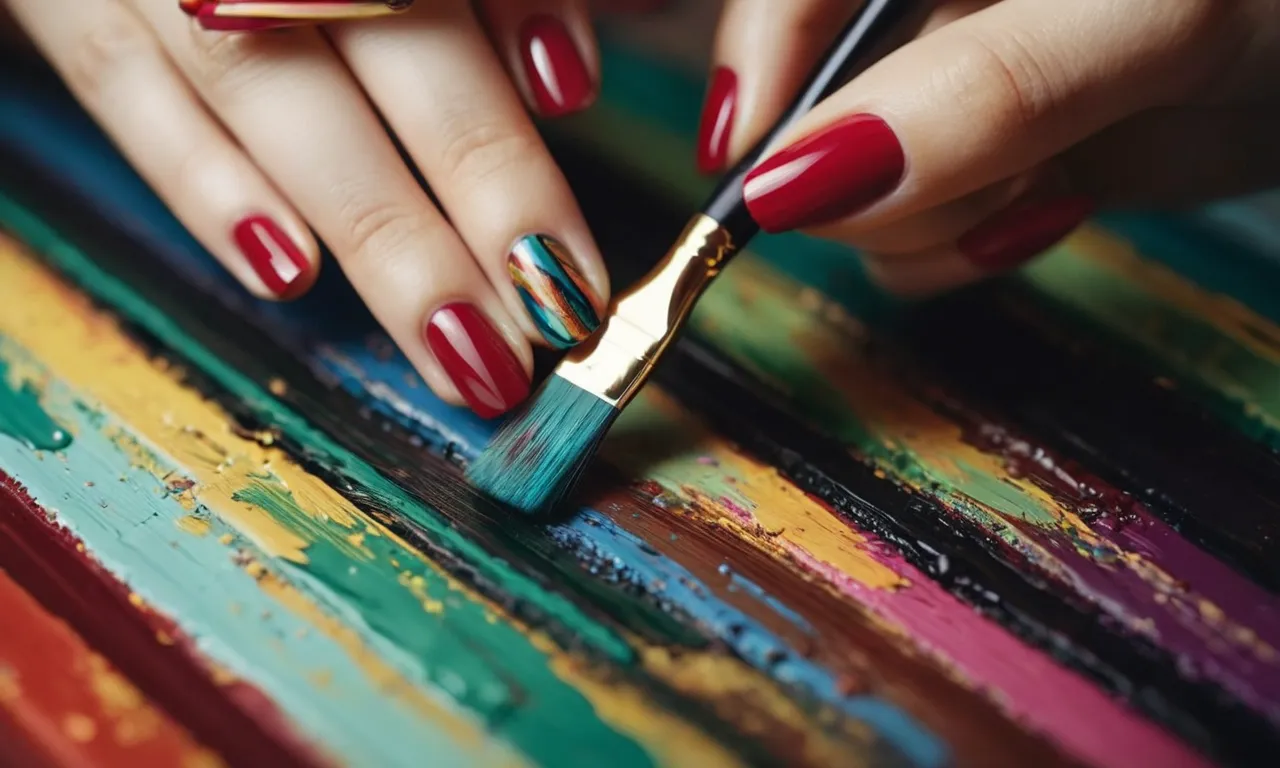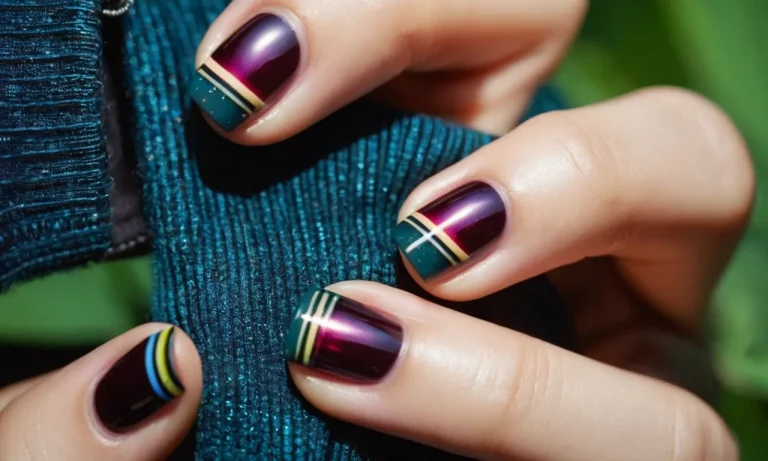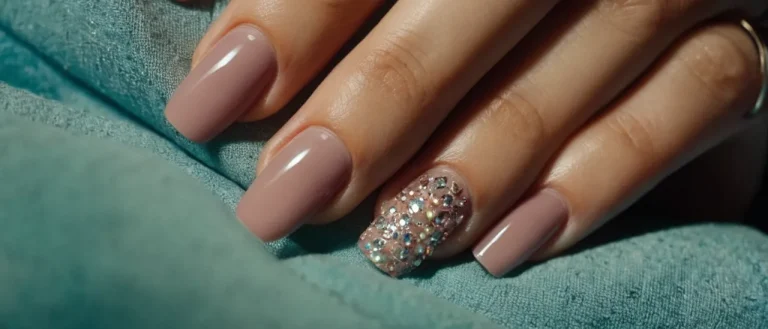Can You Paint Your Nails With Paint?
If you’ve run out of nail polish but have some leftover paint in the garage, you may be wondering if you can use that paint to color your nails instead. Painting your nails is a fun way to express yourself, but not all types of paint are suitable for use on nails.
Read on to learn whether you can safely paint your nails with regular paint.
If you’re short on time, here’s a quick answer: using most types of non-nail paint on your nails is not recommended. Household paints contain chemicals that can irritate or even damage the skin and nails when applied directly. Specialty nail polishes are formulated to be safe for nails.
Hazards of Using Regular Paint on Nails
Toxic Chemicals
Using regular paints like acrylic craft paint or even wall paint on nails can expose you to some seriously toxic chemicals. These paints often contain ingredients like formaldehyde, toluene, and phthalates which can be absorbed through the nails and skin (1).
Formaldehyde is a known human carcinogen, toluene can cause kidney and liver damage, and phthalates are endocrine disruptors. Not fun!
Nail polishes specially formulated for nails don’t contain these nasty ingredients. They use less hazardous alternatives to create vibrant colors without jeopardizing your health. So put down that acrylic paint and step away from the walls! Your nails will thank you.
Skin Irritation
The ingredients in regular paints aren’t just dangerous when absorbed into the body, they can also irritate the skin. Using them on your nails and cuticles may cause redness, itching, burning, peeling, rashes, and even blisters (2). No one wants painful, inflamed nails and fingers!
Nail polishes are designed to be gentle on the delicate skin of hands and nails. Of course some people may be sensitive or allergic to certain ingredients, but in general they won’t cause extreme irritation.
Stick to products intended for your nails to avoid turning your fingertips into a red, peeling mess.
Nail Damage
Painting nails with regular paint can also lead to brittle, damaged nails. Craft paints and wall paints just aren’t formulated with nail health in mind. The ingredients can dry out and weaken nails, causing them to crack, split, peel and break more easily (3).
Nail polishes contain oils, vitamins and moisturizers to nourish nails and cuticles. This helps maintain strength and flexibility for healthy growth. A fresh manicure shouldn’t come at the expense of your actual nails!
Avoid wreaking havoc on your hands by using paints specifically created for safe, non-damaging application.
The bottom line is regular paints contain hazardous ingredients not meant for use on skin or nails. They can be readily absorbed into the body and may also irritate and damage nails. Painting nails is all about creativity and self-expression, but it shouldn’t cost you your health.
When decorating your digits, be sure to reach for nail polish over regular paint.
| Regular Paint | Nail Polish | |
|---|---|---|
| Toxic Ingredients | Usually contains chemicals like formaldehyde, toluene and phthalates | Formulated without toxic chemicals |
| Skin Irritation | May cause redness, itching, rashes | Less likely to irritate skin |
| Nail Damage | Can dry and weaken nails | Contains moisturizers for healthy nails |
Sources:
- EWG Study Finds Potentially Harmful Chemicals in Nail Polishes
- Common Irritants and Allergens of Eczema
- 14 ways you could be causing your weak nails
Types of Paint Unsafe for Nails
Oil-Based Paints
Oil-based paints, also known as enamel paints, use oils like linseed or tung as solvents and carriers for the pigment. While oil-based paints provide good coverage and durability for surfaces like wood or metal, they should not be used on nails (source).
The oils can cause nails to become brittle and dry, leading to cracking, peeling, and breakage. The thick texture also makes application messy. Stay away from oil-based paints on nails.
Latex Paints
Latex paints use water as a solvent and vinyl or acrylics as a binder. They dry faster than oil-based paints with less odor. However, latex paints still contain chemicals and pigments not intended for use on human nails (source). The watery texture causes chipping and peeling quickly.
Latex paints can also irritate skin and damage nail beds. It’s best not to experiment with latex paint on nails.
Spray Paints
Spray paints allow quick, even coverage using aerosol cans. However, most contain solvents like acetone, xylene, ethylbenzene, and formaldehyde that should never touch human nails or skin (source). These industrial chemicals cause redness, irritation, blistering, and peeling.
Spray paint fumes are also toxic if inhaled. Using household spray paint on nails may seem fun but should be avoided.
Craft and Hobby Paints
Paints made for crafting and hobbies may seem harmless, but many contain chemicals unsafe for nails (source). Glitter polishes and fabric paints often have rough textures causing scratching. Acrylic craft paints can peel fast. Model paints and poster colors contain strong pigments that stain nails.
Leather paints have industrial ingredients to adhere to rough surfaces. While alluring, art-store paints should be used with caution on nails.
Safer Alternatives to Paint Your Nails
Clear Nail Polish
Clear nail polish is a safe and easy alternative for those looking to paint their nails using less harsh chemicals. Made without pigments, clear polish provides the hardened protective layer of typical nail polish without unnecessary extras.
According to an article on non-toxic nail options, many clear polishes are now 5-7 free or “3-free,” meaning they are formulated without formaldehyde, toluene, and dibutyl phthalates (DBP). Using a non-toxic clear polish is an excellent way to strengthen nails without exposure to harmful ingredients.
Petroleum Jelly
Slathering petroleum jelly onto nails prior to polishing creates a protective base coat that prevents staining from pigmented polish. Petroleum jelly is hypoallergenic and free from harsh solvents and chemicals.
An article from Fashion Magazine stated using petroleum jelly as a base coat can allow you to remove dark polishes without leaving stains behind. After removing nail color, reapply petroleum jelly to condition nails and cuticles.
Honey
Honey works well as a natural nail polish. It offers light tinting and subtle shine. The antiseptic properties of honey, such as glucose oxidase enzyme, provide nail health benefits and protect against infection. Ankeeper 4 oz. honey bears can be used to directly paint nails.
For longer wear, mix honey with olive oil. Polish nails and allow to dry before rinsing. The nourishing effects will strengthen and condition nails over time.
Beetroot Juice
Beetroot juice has recently gained popularity as a natural nail staining agent. The deep ruby pigments tint nails a pinkish hue like red wine. It is best to mix beetroot juice with lemon juice to help set the stain.
An article on nail care from New Idea recommended painting nails with this mixture and allowing it to soak in for 15 minutes before rinsing. For lighter staining, dilute more with lemon juice. The vitamins and minerals in beetroot juice boost nail health.
Coconut Oil
Coconut oil moisturizes dry cuticles and strengthens weak or brittle nails. Its medium-chain fatty acids help reinforce nail plates. For a protective nail treatment, simply melt solidified coconut oil and massage into the nail bed and surrounding skin.
Allow several minutes to soak in before wiping away excess. This can be done multiple times per week. For added nourishment, mix with honey, olive oil or vitamin E before applying. Over time, nails will grow thicker and stronger.
Natural Henna Dye
Henna-based mixtures create longer lasting stains on nails and skin compared to food juices. Supporters praise its conditioning effects. However, the FDA recommends doing a patch test before overall application to check for allergic reactions.
Mix henna powder with lemon juice or strong black tea to form a thick paste. Apply to nails and allow to set for up to an hour before rinsing thoroughly. The stain results appear within 48 hours as the dye oxidizes and leave nails with an orange tint. Reapply weekly to maintain the color.
Tips for Safely Coloring Your Nails
Do a Patch Test First
Before painting your nails, it’s wise to do a patch test on a small area of skin, like your arm or behind your ear. Apply a tiny bit of nail polish and leave it for 24 hours. If any irritation or redness develops, you may be sensitive or allergic to an ingredient in the polish.
Opt for a hypoallergenic formula instead.
Remove Polish Properly
Always use nail polish remover to take off old nail color instead of peeling or picking it off. Peeling can damage the nail bed. Acetone-free remover is gentler on nails. Moisturize after removing polish so your nails don’t get too dry.
Moisturize Your Nails
Keep nails hydrated with a daily moisturizer or hand cream, focusing on the nails and cuticles. Jojoba oil, coconut oil, and olive oil also work wonderfully. Dry, brittle nails are more prone to cracking and breaking when polish is applied.
Give Nails Time to Breathe
As tempting as it may be to always have a fresh coat of color, try giving your nails a break in between polishing. Having polish constantly on nails doesn’t allow them to “breathe” and can lead to damage over time. Consider going polish-free for a few days each week.
Avoid Excessive Buffing and Filing
Light buffing and filing can help polish adhere nicely, but overdoing it can thin out the nails. Be gentle, buff lightly if needed, and avoid using metal nail files. An emery board is gentler on nails. Also, don’t peel off peeling polish – just let it grow out.
Conclusion
While using regular paints on your nails may seem like an easy nail coloring hack, most paints contain harsh chemicals that can damage nails and skin. Specialty polishes designed for nails are safer options.
In a pinch, you can temporarily stain nails with natural dyes but should still aim to remove any color within a day or two. Taking proper care of your nails is key to keeping them healthy, so skip the paints in the garage if you want pretty, polished nails.







